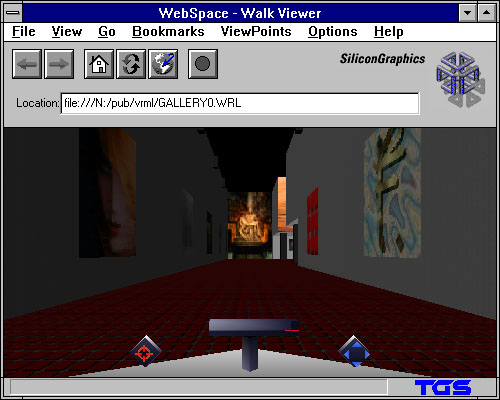![[VR-Pick]](images/vr-pick.jpg) VR-Pick Of The Month - February 1997
VR-Pick Of The Month - February 1997VR-Pick(tm) and the Orbs(tm) Rating System are trademarks of Robert M. Free.
![[VR-Pick]](images/vr-pick.jpg) VR-Pick Of The Month - February 1997
VR-Pick Of The Month - February 1997
An extensive list of VRML 1.0 and VRML 2.0 browsers is available at the VRML Repository.
| NT | Time To Load | Frames/Sec | Rendering | Navigation | Comments |
WebFX beta 4 | 59 Sec | Good image rendering, tiling and materials | Intuitive, smooth navigation | Netscape Plugin Collision Detection Animated Textures Background images | |
VR Scout 1.2 | 1 Min 12 Sec | Good image rendering, very good tiling, problems w/ materials | Improved since last release, but still jerky, and has problems w/ some anchors | Netscape Plugin Partial Collision Detection | |
WebSpace 1.0 beta 1 | 10 Min 16 Sec | Good rendering | Cute navigation tools | TOO SLOW TO USE | |
| World View 0.9e | Failed To Load | No Texture Mapping | Fairly Intuitive | Works fine on small, simple objects | |
| Fountain 0.9 | Failed To Load | Excellent rendering | Terrible UI | TrueSpace compatible | |
| Win95 | Time To Load | Frames/Sec | Rendering | Navigation | Comments |
Virtual Explorer beta 1.1 | 2 Min 13 Sec | Good image rendering, though some images are missing; tiling sizes wrong | Terrible. Some anchors do not work | Collision Detection Improved disk thrashing bug |
WorldView would not launch at 24 bit mode; it launched at 8 and 16 bit mode but failed to load/display the Gallery. Fountain could not load most VRML files I threw at it.
Microsoft's Virtual Explorer does not support NT, and was tested on a 75Mhz i486 with 12M RAM, running Win95, with a Diamond Steath 64 video card at 800x600x24 bits.
The following VRML browsers were tested on a 90Mhz Pentium with 32M RAM, running NT 3.51, with a Diamond Steath 64 video card at 800x600x24 bits.
The VRML world used to test these browsers is Grafman's Gallery -- the Gallery was loaded from a local disk. All browsers were set to their fastest display mode.
Frames per second were measured by counting the number of frames required to rotate 360 degrees, then dividing that by the number of seconds it took to turn a full circle.




Live3D is based on the proposed Moving Worlds specification, which provides portable, 3D automation and behavior via Java. This will be in direct competition to Microsoft's platform-specific Active VRML.
This gives Paper Software's WebFX VRML technology a significant boost in its effort to become the defacto standard for 3D internet presentations and access.
While Paper Software's WebFX still has the edge on navigation and correct VRML material rendering, Chaco's recent 1.2 beta release of VR Scout has made major advances in performance and bug fixes:
Meanwhile, Microsoft's Virtual Explorer has really come along. It has significantly improved on its disk-thrashing bug, it added decent collision detection, and its rendering is very good. However, it is still somewhat slow and navigation is horrendous. Interesting enough, this is one of the few Windows VRML Browsers that cannot run on NT.
None of the other Windows VRML browsers are able to handle Grafman's Gallery.
Paper Software's WebFX was one of the few VRML browsers able to load and render VR Snowman, without blowing out your Virtual Memory.
VR Snowman is surrounded by falling snowflakes. Using negative numbers for the body segments, you can generate a star background, visible on some VRML browsers (ie. WebFX).